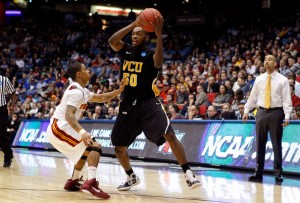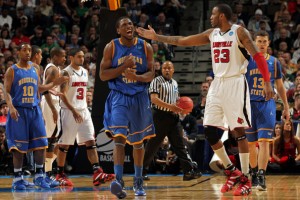Mid-Majors Prove They Belong in the NCAA Tournament

The VCU Rams have shown that they belong in the NCAA Tournament with a pair of victories against power conference schools.
When the bids for the NCAA Tournament were announced last Sunday, much venom was dispersed by self-proclaimed tournament “experts” about how the committee had made a huge mistake in selecting a pair of non-power conference teams (VCU and UAB) over supposedly more deserving schools from major conferences.
The under-pinning message in their comments was that it was okay for teams with 14 losses from major conferences to receive at-large bids for the NCAA Tournament, but heaven forbid the committee award schools from conferences with less national prominence for their solid seasons.
Their argument seemed to be justified after UAB sleep-walked through an opening round loss to Clemson.
However, since that game, schools from conferences outside the so-called “Power 6” (ACC, Big East, Big Ten, Big 12, Pac-10 and SEC) have more than held their own against schools from the power conferences.
It started with a victory by VCU over USC in the second of the opening round games between at-large tournament teams.
In the second round of the tournament, there were 12 games in which power and non-power conferences met in games between teams seeded from 4th through 13th.
Of those 12 games, the power conferences claimed six victories and the non-power conferences claimed six victories with the non-power conferences winning two of the three games in which both teams were at-large tournament selections. Eight of the 12 games were decided by five points or less with the two largest margins of victory being posted by non-power schools (VCU defeating Georgetown by 18 and Gonzaga crushing St. John’s by 15).
This illustrates that when playing on a neutral site, there isn’t significant difference between the so-called “big boys” and their lesser funded “country cousins.”

Morehead State was just one of several non-power conference schools to knock off the "big boys" during the opening rounds of the NCAA Tournament.
Despite runs in recent NCAA Tournaments by schools such as George Mason, Davidson and Butler, it seems that many basketball analysts are still reluctant to concede that success by these schools is more than just a fluke and result of individual circumstances instead of a reality that the “power” conferences aren’t really as dominant as they want to make us all think.
This year the Big East received a record 11 tournament bids and seven teams from power conferences received at-large bids despite having 13 or more losses.
Yet, the national “experts” crushed the selection committee for giving at-large bids to UAB (eight losses) and VCU (11 losses) while justifying all the bids to power conference schools.
However, once the focus went from the analyzing the selections to playing the games, the non-power conferences have proven their worthiness.
Excluding games featuring teams seeded 1-3, there were five games in which Big East teams faced teams from non-power conferences. Ironically, the only Big East team in this group to win their opening game was Marquette (one of those 14 loss teams), which as the 11th seed was actually the underdog to sixth seeded Xavier.
The other four games were won by the non-power conference school with Colonial Athletic Conference squads George Mason and VCU posting two of the wins, 11th seed Gonzaga defeating St. John’s and 13th seed Morehead State edging Louisville.
The other two wins by non-power leagues came from Atlantic-10 squads Temple and Richmond. The Owls defeated a Penn State squad that earned a bid despite entering the “Big Dance” with 14 losses. The Richmond Spiders, whose 27-7 record and conference tournament title seemingly should have been rewarded with better than a 12th seed, defeated fifth seeded Vanderbilt from the SEC.
In addition to these six teams, the round of 32 also includes three non-power conference squads (San Diego State, BYU and Butler) that defeated other non-power league squads to reach the next round.
Because money is the ultimate driver to this entire effort, you can bet that even though non-power conferences annually prove that they belong in the “Big Dance”, it will only get harder for schools from the non-power leagues to find their way into the tournament as at-large participants.
However, hopefully the NCAA Selection Committee will continue to recognize that these programs do deserve inclusion in the tournament and not place so much stock in power conference teams with mediocre records.
The stature of the NCAA Tournament as one of the most preeminent events in the sports world has been created under the guise that every team in the field (even those from the non-power conferences) has a chance to win. Lets hope the tournament committee continues to provide non-power conference schools with the annual chance to prove that they belong.














